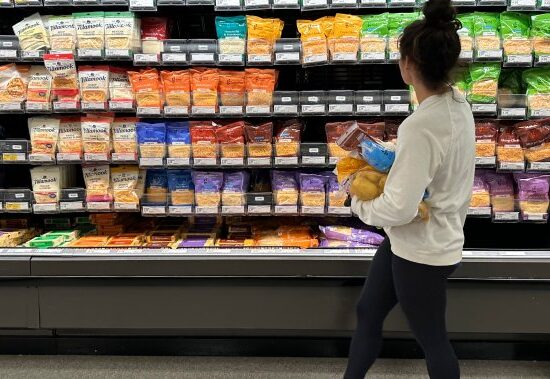
Luminate’s Year-End Report shares trends in the music industry, including album sales, streaming numbers, and how content is consumed. 2022 boasted a variety of new data.
Luminate’s annual report about the music industry showcases trends by the year and how audiences are consuming music. It follows what albums and songs people are listening along with and how they are consuming the content.
For starters, Bad Bunny’s album, Un Verano Sin Tin was the most consumed album in America, marking the first time that an album featuring music recorded in a language outside of English achieved that goal. The album has been a smash hit, becoming the second non-English album to reach number one on the Billboard 200 chart, the first being Bad Bunny’s previous album, El Ultimo Tour del Mundo in December 2020.
In terms of the music industry as a whole, album consumption, which includes “album sales plus the equivalent value of song streams and sales,” went up by 9.2% in 2023. Although the numbers still increased, it was a smaller gain than the 11.3% raise that was seen in 2021.
Streaming looks to still be the main way audiences listen to music, with 84% of US revenue in the Recording Industry Association of America (RIAA)’s mid-year report being attributed to streaming. 2022 was the first year that more than 1 trillion streams were played across America.
According to the Luminate data, as reported by Variety, audiences are also listening to songs longer, with catalog repertoire, which is a music product, “that has been on the market for 18 months or longer,” representing 72.2% of music consumption.
Songs appear to be more likely to last longer than a one-hit wonder or splash-in-the-pan single that has a limited window of popularity. Music looks to have a longer impact on listeners than in previous years.
This also may be due to the fact that with streaming, the actual content of what users are listening to is being tracked as opposed to previously when it was what albums people purchased that was the focus. With an album purchase, there is no way to know what songs are listened to the most on the album, whereas with streaming, the songs are the ones that stand out and lead to specific data about consumers’ listening habits.
A senior executive from one of the major labels sees this as a good thing. “I think it’s good that music fans are discovering great music, regardless of the era it came from. We should be agnostic as an industry to how someone wants to attach to something. It cannot always be about a new release,” he says.
“If they decide to spend five minutes or four minutes on a song, or 30 or 40 minutes on an album from a particular artist, regardless of when it came out, it’s a good thing for the business.”
From a business point of view, the focus is not on whether or not consumers are listening to a particular song by an artist, a song that just came out from the artist, or a song from the artist that came out months or even years ago. The focus is on the artists’ music being listened to at all.
The executive went on to explain how there’s competition for entertainment nowadays with the likes of sports, television, and film streaming services like Netflix, and social media apps like TikTok. Any time that consumers give to an artist and their music is still beneficial for the business.
“Shallow catalog” is a term that some music executives use to describe songs that came out a bit more than 18 months prior and still are generating sales. While current and new sales are still important, others point out that those singles from some time ago are just as important, as streaming has shown the longer-lasting impact of particular singles.
With TikTok, it is common to see songs from years and even decades ago suddenly become popular due to recent trends. An example would be the success of Kate Bush’s “Running Up That Hill” which was released in 1985. While it reached the Top 40 charts nearly 40 years ago, it received a resurgence in popularity due to its 2022 appearance in Netflix’s Stranger Things.
While the song is not a current and new song, it is a new song to a whole new generation of listeners who either discovered it in such places as the series or TikTok.
However, albums are still popular, as artists like Bad Bunny, Taylor Swift, and Harry Styles sold 3.4, 3.3, and 2.2 Million album project units respectively in 2022.
For the consumption chart, 2022 albums from artists including the Weeknd, Future, and Little Durk sold over a million units, and albums from the previous year by artists including Drake, Olivia Rodrigo, and the soundtrack from Disney’s Encanto also sold over one million units, being 2021 releases making the 2022 list.
Looking at sales, Taylor Swift’s Midnights was the top seller with, “1.8 million physical copies and downloads combined in barely more than two months.” 2022 titles that made the list include albums from artists such as Beyonce, BTS, and Tomorrow X Together. 2021 titles also made the list with albums from Adele and Olivia Rodrigo.
When discussing albums that are older than eighteen months, Fleetwood Mac’s Rumours from 1977, Kendrick Lamar’s Good Kid, m.A.A.d City from 2012, and Michael Jackson’s Thriller from 1982 came from earlier decades but still impact the album sales charts with their popularity, selling 310,000 units, 278,000 units, and 236,000 units respectively.
Vinyls outsold CDs in the US, while country and rock are the two genres that have the most radio listeners, with their fans more likely to tune in to genre radio stations as opposed to videos, audio streams, and video streams.
Cassettes grew in popularity by 28% over 2021, although the numbers are still low.
Music is also consumed differently based on the artist and fan base. 95.8% of sales for Bad Bunny’s album, Un Verano Sin, Ti came from streams and 4.2% from digital albums. Meanwhile, album sales, “accounted for more than half,” of Beyonce’s album, Renaissance, the total amount of sales, where vinyl was the highest medium at 36.4% for Taylor Swift’s latest album, Midnights.
Another interesting tidbit on vinyl sales, is “only 50% of vinyl buyers own record players,” which begs the question of how many people listen to the vinyl and how many buy it as a collector’s item.
Digital downloads have been going down ever since streaming took over as the top method of music consumption in 2015. Other tidbits include the fact that “hip-hop fans are 26% more likely to buy music merch online from a separate brand, while country fans are 31% more likely to get theirs at a live music event… Children’s, world, electronic/dance, and classical have joined Latin as genres growing faster than the industry pace.”
In addition, Gen Z spends, “19% more time with music per week and 10% more money on music per month than the average consumer.”
The music industry has dramatically changed over the years and it is fascinating to see where it will go next.













